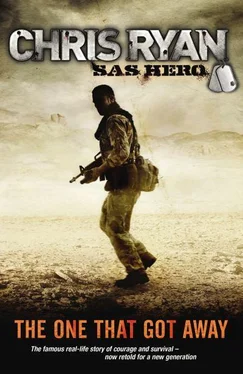Suddenly a shot cracked out from within the hospital. A hostage had been executed. The terrorists called for a stretcher party to take the body away. The front door opened briefly, and a limp figure was bundled out. A four-man team ran over to collect it. Then the chief terrorist threatened to kill another hostage in half an hour if his demands were not met.
The moment had come for the police to hand over to the military. The police chief signed a written order passing command to the OC (Officer Commanding) of ‘B’ Squadron, the senior SAS officer present. The OC then gave the three eight-man assault teams their orders. The moment he had finished, the men moved to their entry points.
Now it was just a question of waiting for my snipers to get as many terrorists in their sights as possible. Listening to our commentaries on the radio, the OC suddenly called out the order we’d all been waiting for:
‘I have control. STAND BY… STAND BY… GO!’
For the past two days the grounds of the old hospital had been eerily silent. Now the whole place erupted into action. Two vehicles screamed up to the building and a swarm of black-clad assaulters jumped out. Explosive charges blew in the windows. Within seconds, a Chinook helicopter was poised above the roof and more black figures were fast-roping out of it, abseiling down to the windows or entering through the skylights. Stun grenades blasted off; smoke poured out. The radio carried a babble of shots, shouts, explosions and orders.
In a matter of minutes the building had been cleared, the five terrorists killed and the remaining eight hostages rescued. The assault commander reported that he had control, and command was formally handed back to the police.
* * *
On this occasion, this had all been just an exercise — but as always, the assault had been realistic in every detail, and had been excellent training. Just another day for the Regiment, as members of the SAS refer to themselves. And exactly the kind of task we could at any time be called upon to perform, efficiently and explosively. Practice was essential.
‘Well done, everybody,’ the OC told us. ‘That was pretty good.’
We packed our kit into the vehicles and set out for SAS headquarters in Hereford. But on the way events took an unexpected turn.
It was 2 August 1990, and on the news we heard that Saddam Hussein, the tyrannical leader of Iraq, had just invaded Kuwait, a small country on his southern border.
‘So what?’ said one of the guys scornfully. ‘Saddam’s an idiot.’
‘Don’t be too sure of it,’ said someone else. ‘It’ll make big trouble, and we’ll probably find ourselves out there.’
He was right. Saddam’s invasion of Kuwait was the opening salvo of the 1990–1991 Gulf War. I don’t think any of us realized just how this news would change our lives.
* * *
For the next two months, nobody knew what was going to happen. The leaders of different governments around the world got together to discuss the situation and the UN Security Council called for Iraq to withdraw from Kuwait — and gave them a deadline. When the Iraqis did not leave Kuwait, a war was inevitable. In total thirty-four countries joined together in a coalition to oppose Saddam Hussein. These countries included not only the USA and Great Britain but also Arab countries in the Middle East region, like Egypt and Syria.
‘A’ and ‘D’ Squadron went out to the Gulf for build-up training; but me and my mates in ‘B’ Squadron were told we wouldn’t be going, as it was our turn to take over what are known in the SAS as team tasks — assignments for which small teams of men are needed in various parts of the world.
The SAS is made up of four squadrons — A, B, D and G. Each squadron is made up of four troops — Air Troop, Mountain Troop, Boat Troop and Mobility Troop. There should be sixteen men in each troop, but because it is so difficult to get into the SAS, there are often as few as eight.
Rumours started to fly. Some people said we might become sky-marshals on civilian flights to the Middle East. It would mean pretending to be normal passengers, but in fact carrying weapons to deal with any terrorist who might attempt a hijack. The idea seemed quite likely — on the SP team we’d done lots of assaults on and inside aircraft, so we knew what to do.
But then, a week before Christmas, we were dragged into the briefing room at Hereford and told that half of ‘B’ Squadron was going to deploy to the Middle East after all.
That meant me.
When I heard the news, I went home and said to Janet, my wife: ‘Listen, we’re heading out.’ Normally, as so many missions are top secret, SAS guys say nothing to their wives and families about what they’re doing, but in this case it was obvious where we were going. After Saddam’s invasion of Kuwait, there had been so much coverage on television and in the newspapers, our destination could only have been the Gulf.
Christmas was not a relaxed time. The Regiment was stood-to throughout the holiday period, and we were busy getting our ‘green’ kit ready. In the SAS, ‘green’ refers to normal military operations, as opposed to ‘black’ work, like that on the SP team, for which you wear black gear from head to foot. I’d been in black roles for at least three years, so now I brought my webbing and bergen home to paint them in desert camouflage colours. We were having an extension built onto our house, and a builder called John was digging the footings. Seeing me at work outside, he came up and asked what I was doing.
‘Just painting my webbing.’
‘Those colours are a bit light, aren’t they?’
‘Well,’ I said carefully, ‘you’d be surprised. It works quite well.’ In fact, he was right: I had the colours too light and sandy, as I was to find out to my cost.
Packing our kit took some time. All our weapons were bundled together and went separately, rolled up in canvas sleeves. When I asked the squadron quartermaster (SQMS) if he’d included pistols, he said, ‘Yeah, twenty of them.’ I was glad about that, because pistols were essential back-up weapons. We would need them if our own weapons failed or if we were caught in a confined space like a vehicle, or an observation post. Most of us would be carrying either M16 203s — a combination of a 5.56 calibre automatic rifle in the top barrel and a grenade launcher below — or Minimi machine guns. Both are over a metre long and awkward to handle or conceal.
As I was sorting my personal equipment, I asked the SQMS if I could take some cold-weather mountaineering gear.
‘Nah,’ he replied. ‘You’re going to the desert! It won’t be cold there.’ Little did he know what the winter in Iraq would be like. I kept thinking that we might end up at high altitudes, in the mountains of northern Iraq on the Turkish border, where snow might be lying. It was as if I had some premonition. But I did nothing about it, and most of us didn’t take any cold-weather gear at all.
At last we heard that we were to fly out.
On the night of Saturday 5 January 1991, a Tristar took us from RAF Brize Norton, landed at Cyprus to refuel, then flew on to the Gulf, where it taxied up behind a hangar. Getting off into the warm night, we found the OC, the Squadron Sergeant Major (SSM) and the SQMS lined up waiting for us at the bottom of the steps, all wearing desert kit or Arab shawls called shamags, wrapped round their necks like scarves. It was our first sight of anyone dressed like that, and it brought home to us where we were.
A Hercules was parked alongside and we jumped into the back. There were no seats or straps, so we sat on the metal deck for the short flight up to our Forward Mounting Base (FMB), known as Victor. This was near Abu Dhabi in the United Arab Emirates.
Читать дальше












